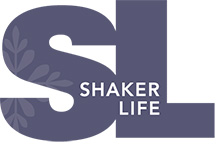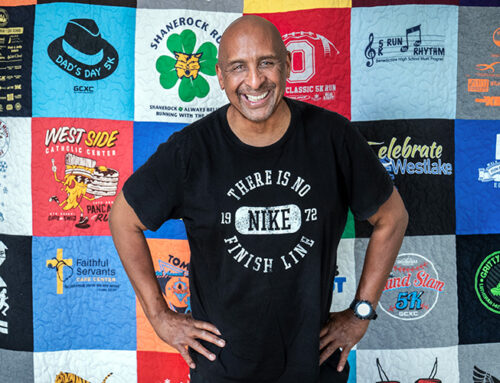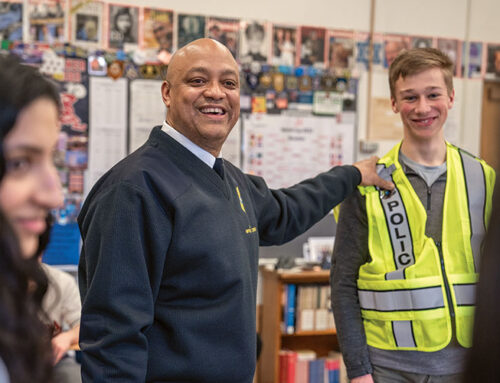The Shaker Heights Police Department is working to build positive relationships throughout the community. Its goal is to make sure residents can see and feel that connecting with the community – in everything from hiring new recruits to interactions with youth – is at the heart of police work in Shaker.
By Jennifer Kuhel
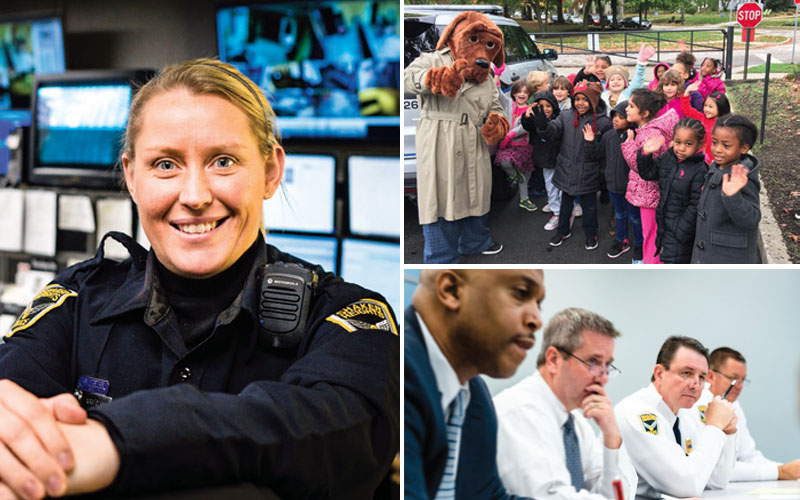
Shaker Heights police department
When Shaker Heights Police Chief Jeffrey DeMuth was sworn-in in 2016, he did so against the national backdrop of a growing anti-police sentiment and waning confidence in law enforcement.
He knew that Shaker Heights wasn’t immune to those feelings. “If someone called the police and then had a bad experience, that experience sticks in their minds,” DeMuth says. “We accept responsibility for that.”
He also understands that the first step to improving a relationship and rebuilding trust is to confront issues honestly and to engage in the often uncomfortable conversations that demand listening and open-mindedness from both sides. It’s hard, but necessary, he says.
And it’s what’s driving DeMuth and the police department towards something better for the community and for police: adopting a mindset that values customer service and emphasizes communication, cooperation, and legitimacy over commands, compliance, and authority.
The department’s goal is to ensure residents can see, feel, and know that connecting with the community—in everything from hiring new recruits to social media postings to interactions with youth—is at the heart of better police work in Shaker.
A New Mission
Soon after he arrived, DeMuth assembled the department’s supervisors and asked them to help him draft an updated mission statement. “The old one was very long. No one knew it, lived it, or understood it,” he explains. “We wanted to create one that was impactful and memorable.” In the new mission statement (see below), the words “partnership with the community” are front and center. The emphasis on education and development for officers is unmistakable. By the end of 2016, the mission statement was printed and hung in poster-sized frames all around the department. It read:
In partnership with our community, strive to ensure safety and security through crime prevention, traffic safety, and criminal investigation, while creating a work environment that recruits, trains, and develops outstanding employees.
Making sure everyone in the department understood and internalized the mission was the first step. The next step was to craft a hiring process that attracted applicants who were simpatico with that mission.
The Right Hires
All sworn Shaker Heights police officers (and Fire Department employees) are hired and promoted by the City’s Civil Service Commission, a three-member commission whose members reflect the diversity of the City. Each member is appointed by the mayor to a six-year term. Current commission members are Ronald Fountain, Sandra Kiely Kolb, and Lee Trotter.
Here’s how the process works:
Any new hiring cycle starts with a public announcement of openings. The announcement is widely promoted in the local press and on the City’s social media channels. A diverse team of officers also attends recruiting events and “reaches out to our local police academies, local churches, and police organizations like Cleveland’s Black Shield Association and the National Organization of Black Law Enforcement (NOBLE),” explains Sgt. Tim Grafton, who oversees the department’s Community Engagement Unit.
Applicants must bring their completed applications in person to City Hall. The City accepts the first 50 completed applications and submits that list to the Civil Service Commission for approval. (In the 2019 round of hiring, due to waning interest in a career in law enforcement nationally, the City did not hit that threshold.) Approved applicants are tested and ranked for hiring, based on their scores.
In 2017, the City completely overhauled its testing procedure.
Historically, the written test given to candidates wasn’t always as helpful as the police department hoped because they evaluated cognitive abilities, without assessing the emotional intelligence required of good police officers. The tests failed to give a complete picture of an applicant and presented a considerable obstacle to the department’s desire to hire the most diverse, multi-skilled police force possible.
So in 2017, DeMuth reached out to the City’s Human Resource Manager, Sandra Middleton, for help in finding a test that would provide a better measure of a candidate’s emotional maturity to handle police work.
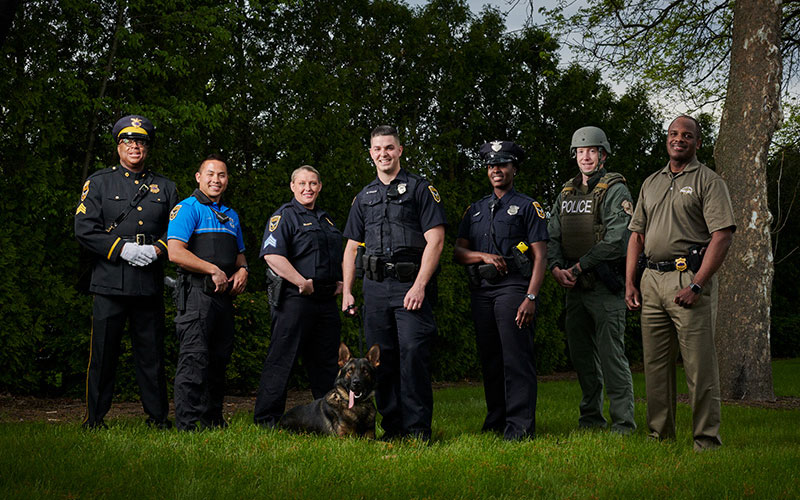
Members of the Shaker Heights Police Department.
“An applicant might be good at math, but that’s not always a skill that will translate to being a good police officer. We wanted to learn about an applicant’s practical police skills and how they might fit in with our community,” explains Middleton. “We need quick thinkers, critical thinkers, and applicants who could make good decisions for our residents under pressure. And they needed to have solid communication skills because we want officers who can engage with the community.”
After a month-long search, Middleton found a company that offered a structured interview format in which a specially trained, three-person panel of community stakeholders, residents, and police officers would ask applicants the same seven pre-scripted questions, many about race relations. The test was labor intensive, with an interview time of 30 minutes per applicant, which meant 25 hours of interviews. However, the upside was clear: Questions on the test would provide the interview panel with a better idea how an applicant would respond to a situation encountered as an officer in Shaker.
Middleton and DeMuth presented the test option to the Civil Service Commission and it was approved, making the SHPD the first police agency in the state to eliminate the written test and adopt a structured interview test for new officer candidates.
The first run of the new testing procedure came in November 2017. The police department announced a call for applicants and was hopeful the new test would provide better insights into the candidates. Almost 70 applicants responded to the call, many of them lining up at City Hall at midnight on the day applications were accepted.
“We were getting people in the door, but we didn’t know if we had the right people taking the test,” DeMuth says. The department assembled the interview panels, which included a diverse group of residents, Shaker Schools officials, and police officers, then trained them on the process, and set off to answer the Chief’s lingering question.
Jim Norris, a 30-year Shaker resident and graduate of the Citizens Police Academy, served as a citizen panelist.
Norris recalls one applicant in particular who was pleasant and bright. “But after the interview, I wasn’t sure that he could handle the types of confrontations he might see on the force. He certainly may be able to develop those skills, but he doesn’t have them yet.”
(At that time, citizen panelists were also members of the Shaker Heights Citizens Police Alumni. More recently, the department expanded the pool of potential interviewers to include all residents. Residents interested in being considered for future panels should subscribe to City ENews where the City announces calls for volunteers.)
Christine Bretz, who participated in five interviews, found the process was well-defined with good results. Despite the time the interviews took, “we achieved the goal of getting the candidates we wanted,” says Bretz. “I applaud the fact that SHPD wanted citizen involvement because, after all, we’re the end-consumers of their service.”
Next Steps
The results of the interviews are submitted to the Civil Service Commission. The interviews are graded according to a predetermined rubric, not simply based on the interviewers’ impressions.
“We’re looking for them to hit certain dimensions,” explains Grafton. “Say the question is, ‘What do you think of police work?’ We’re looking for them to talk about things like service, dedication, commitment, integrity. As they hit these different benchmarks, they get scored.”
The Commission allows the department to move forward with the top 20 passing candidates. The next step: background checks for those candidates.
This “check” is handled like any police investigation. The department thoroughly researches each candidate’s professional and personal backgrounds, even conducting visits out of state if necessary. “These are manpower intensive investigations,” says Grafton. “We can easily spend 30 or 40 hours.”
Certain findings – say, a criminal record, a record of domestic violence, or a “severely” negative driving history – will disqualify an applicant.
Employment offers are made as applicants pass the background check, depending on the number of hires the department allowed. “We are able to hire officers as they pass the background investigation,” explains Grafton. “So even though the candidates take the test at the same time, they may get hired on a different schedule.”
Improving Diversity
Back in 2017, it was immediately clear that the new testing procedure had a positive impact on the Department’s goal to have a diverse force.
“That first candidate pool submitted for approval by the Civil Service Commission was among the most diverse we’d had up to that point,” recalls Middleton. “And this new testing process has continued to help us hire men and women from a range of races and ethnicities, just like the community itself.”
Today, 25 percent of the Shaker Heights Police Department identifies as a member of a minority group; 20 percent are African American (the national average for police departments is 12 percent).
“We’re particularly proud of this given the current challenges in recruiting minority candidates,” says Chief DeMuth.
“The overall applicant pool for police officers is down across the nation. But it’s even more so for minority applicants,” he explains. “Unfortunately, Ferguson and other events showing racial bias in policing have slowed diversification efforts. For obvious reasons, minorities are hesitant to join a profession where there is perceived racial bias.”
Still, such challenges notwithstanding, diversity remains an ongoing priority for the department. And each new hiring cycle is approached as an important opportunity to further diversify the department.
“Is our hiring process rigorous and time consuming? Yes, it is, especially when compared to other communities,” says Middleton. “But it’s necessary if the police force is going to reflect the values and demographic makeup of Shaker’s residents.”
“This is the Shaker way,” Middleton says. “We want top-notch officers.”
(Social) Media Savvy
A 2015 social media survey by the International Association of Chiefs of Police revealed that 96 percent of all participating law enforcement agencies utilize social media. The most common use: assistance in criminal investigations. SHPD is no exception. Crime-related SHPD Facebook posts help lead to tips that help solve the posted crime.
SHPD created its Facebook page in 2014, under the direction of late Police Chief D. Scott Lee. Lee wanted to use social media as a tool to fight crime, educate residents, and more importantly, to put a human face on the force. He asked Lieutenant Marvin Lamielle, who heads the Department’s Investigation and Engagement Units, to be the first administrator.
Since 2014, Lamielle has grown the number of followers on the SHPD Facebook page to more than 8,000. The Department’s Twitter account now has more than 1,600 followers.
Scroll through the posts from the department’s Facebook page and there’s a mix of photos of officer visits to schools, alerts that inform residents on crime prevention, and requests for crime-solving tips. Plus, the immensely popular “SHPD Furiday” posts featuring the department’s beloved K9s.
Overall, resident response has been largely positive and enables police to interact with residents in ways not previously possible. This is particularly the case with posts that help educate residents about how their actions – for example, keeping garages, cars and doors locked — can help reduce crime in the community.
“Our social media efforts serve as an effective way to promote a collaborative effort between the police department and the community,” explains Lamielle. “By sharing our knowledge of what criminal trends are in the community and greater Cleveland area, our residents can serve as a force multiplier by helping to diminish the conditions that attract criminal acts in our neighborhoods.”

The Department’s Bike Patrol, introduced in 2018, helps get officers out in the community.
Connecting with Youth
In late 2017, members of the Police Department met with officials from the Shaker Heights School District to discuss development of a joint police-schools program called Police Awareness and Student Safety (PASS). PASS fosters relationships and improves interactions with students, faculty, and staff at all levels, but with a particular focus on high school students.
Keith Langford, coordinator of Family and Community Engagement for the District, hosted an open conversation at the high school, inviting all students to a discussion with school officials and police on building a stronger relationship.
The discussion was a success, with more than 50 students of different grade levels and 10 police officers in attendance. Most of the students submitted questions anonymously on notecards or asked in person. “We had terrific engagement from both the students and police,” says Langford. “I think both parties came away with a better understanding of how each can improve the relationships moving forward.”
Many of the questions revealed students’ concerns with current events, including use of force and the Black Lives Matter movement. “We were able to see things through their eyes,” DeMuth says. “Part of our job was to dispel some of the myths about law enforcement generated by the media, and some of it was to acknowledge what’s been happening.

The SHPD’s Honor Guard.
But the involvement with Shaker Schools – or its students — doesn’t end there. Officers regularly participate in District events and also take part in monthly Shaker Engagement Collaborative meetings, which include representatives from the Shaker Schools, Shaker Library, the City, and area organizations.
In 2019 alone, 73 officers participated in 53 community events, many at schools, but also at churches, local not-for-profits, and at the police station itself, where officers regularly provide tours and other educational programming for the community.
And, often, engagement happens more informally, like when officers are out and about or when residents reach out with concerns. For example, last August a group of mothers of students at Shaker Heights High School asked to meet with the chief. The goal: to start a conversation around police interactions with their – and other – students, especially students of color. That meeting was so productive the group has plans to continue to meet informally this year.
“As a mother of two African American sons, of which my youngest son participated in this meeting, I think it presents the opportunity to open the door of understanding and education for both parties: our young men and our police officers,” notes longtime resident Dr. Tamika Thomas Rashid. “I hope further opportunities that bridge connection, communication and dialogue with our young residents can occur.”
Moving Forward Together
Three years after adopting its new mission statement – in “partnership with the community” – DeMuth and his department remain committed to delivering a product that’s better for residents.
Certainly, the trend is in a positive direction. In 2019, part 1 crimes dropped to their lowest level in Shaker Heights: 353, down five percent from 2018’s 371.
“We understand that our message isn’t always going to hit a resident directly,” says the chief. “But if it starts at the top and we live and breathe our mission, vision, and values, and it works its way through the ranks, then the folks who need to experience it are going to see that change.”
Originally published in Shaker Life, Spring 2017. Updated June 2020.
